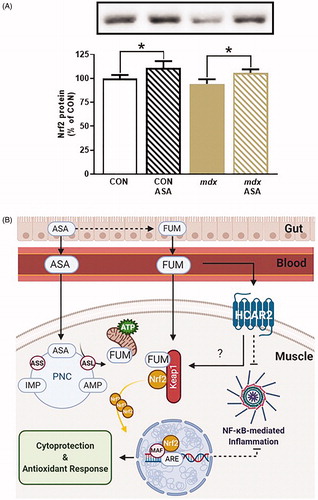Figures & data
Figure 1. Adenylosuccinic Acid (ASA) is a novel inducer of nuclear factor erythroid 2-related factor 2 (Nrf2). Basal Nrf2 protein expression is comparable but ASA treatment induces Nrf2 in CON and mdx quadriceps (p < .05 treatment effect (A). Data is mean Nrf2 protein normalized to the total protein signal in in each lane ± SEM with representative bands; n = 6–8. In a proposed mechanism of action (B), ASA is converted to bioactive fumarate (FUM) either in the gut epithelium or in target tissues which express adenylosuccinate lyase (ASL). ASL converts ASA to FUM and recovers inosine monophosphate (IMP) to adenosine monophosphate (AMP) in the purine nucleotide cycle (PNC). ASA is endogenously re-synthesized through adenylosuccinate synthase (ASS). FUM is shuttled into the mitochondria to stimulate oxidative phosphorylation or binds cytosolic Kelch-like ECH-associated protein-1 (Keap1) to interrupt Nrf2 repression. This prevents Nrf2 ubiquitination and degradation leading to protein accumulation (A&B). Nrf2 translocates nuclearly where it heterodimerizes with MAF proteins to transcribe the antioxidant response element (ARE) and induce the cytoprotective and antioxidant response. Circulating FUM can also activate the hydroxycarboxylic acid receptor 2 (HCAR2) which, like Nrf2, exerts strong anti-inflammatory activity through the inhibition of nuclear factor kappa B (NF-κB). Created with BioRender.com.

